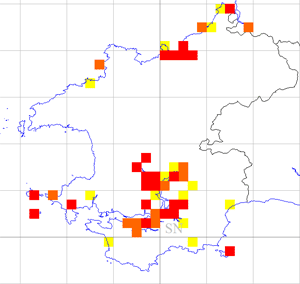Shelduck - 2003-07
 Monday, May 7, 2012 at 3:28PM
Monday, May 7, 2012 at 3:28PM In Pembrokeshire, Shelducks are strongly associated with estuaries, in particular the Milford Haven Waterway and Daugleddau Estuary, and its associated embayments and tributaries. In the 1984-88 survey, breeding Shelducks were also recorded on the Teifi Estuary, and on Caldey Island.
A comparison between the 1984-88 and 2003-07 breeding surveys reveals changes in the distribution of breeding Shelducks in the county, as shown on the tetrad maps.
Some of the more significant changes include the disappearance of Shelducks as a breeding species from the southern side of the outer Milford Haven Waterway, e.g. in Angle Bay/Kilpaison, and from coastal sites such as in the Freshwater West area. There have also been gains, with Shelducks breeding on Skomer and Skokholm Islands and on the Nevern Estuary. Breeding Shelducks were also present on the Teifi Estuary. The number of tetrads in which Shelducks were recorded as confirmed or probable breeding had also increased by 2003-07, from 31 to 36, with possible breeding recorded in a further 14 tetrads.
One or two of the records of possible breeding on the exposed open coast need to be treated with caution. Pairs and small groups of Shelducks are a common occurrence on the open coast in May and June, either resting on the surface of the sea, or on the cliffs above (J. E. Hodges, pers. obs.).
Some of these birds may well be non-breeders en-route to moult grounds. Moult migration in Shelducks is well-defined. First and second year birds leave for the moult grounds from May onwards, to be followed by non-breeding adults or failed breeders later in June and early Jul. By mid-July all non-breeding Shelducks, together with adults that are not minding ducklings, have left the Milford Haven Waterway and Daugleddau Estuary for the moult grounds (Hodges, 1992-2008).
Following the 1984-88 survey, the breeding population of Shelducks in the county was estimated to be around 50 pairs. In the period 2003-07, the numbers and sizes of broods of ducklings seen in the Milford Haven Waterway & Daugleddau Estuary varied each year, from 10 to 22 broods. In addition, several territorial males and pairs without broods (but which may have attempted to breed) were recorded in each of the five seasons. Taking into account the breeding pairs on the islands; in the Newport area and on the Teifi Estuary, together with pairs scattered around the county, 60 – 70 breeding pairs might be a reasonable population estimate.
Caution should, however be exercised, since Shelducks are known to “dump-nest”, whereby females lay their eggs in another female’s nest, leaving the owner of the nest to incubate the eggs and lead the newly hatched ducklings to water along with their own ducklings. “Dump-nesting” is sometimes indicated by large broods, e.g. of nine ducklings or more, and almost certainly occurs amongst the Shelduck population in Pembrokeshire.
Jane Hodges

Fieldwork 2003-07 (based on 490 tetrads)
Red = breeding confirmed = 23
Orange = breeding probable = 13
Yellow = breeding possible = 14
Total tetrads in which registered = 50 (10.2%)
 JEH,
JEH,  PBBA 2003-7 in
PBBA 2003-7 in  Shelduck
Shelduck 

Reader Comments